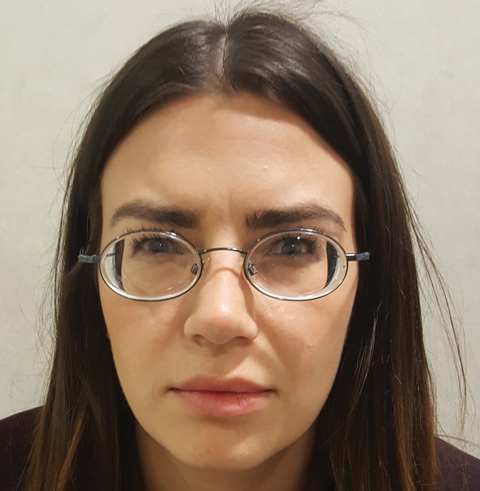 |
Early on, budding optometrists latch onto a drive to push for the highest level of visual acuities possible, and they take pride in providing their patients with ever-sharper visual acuity measures. This need for clarity, achieved with extra minus, can come at an expense. Too often, the extra few clicks of minus cause unintended nearpoint consequences. However, with careful attention, this does not have to be the case.
New Kid in Town
When Dr. Harris was a third-year student, he was playing in an orchestra next to a trombone player, Mike, who had strabismus and wore only one contact lens—he left the other eye uncorrected. Dr. Harris was given the opportunity to examine him to practice some of the clinical techniques he was learning.
Although his polymethyl methacrylate contact had not been checked in several years, his acuity through the contact was an excellent 20/20, while the other eye was much worse than 20/200. Dr. Harris performed an over-refraction of the eye with the contact and got a surprising +3.00, which also gave 20/20. Dr. Harris scratched his head and proceeded to have him remove the lens. His retinoscopy was close to +0.50, and his refraction was right around +0.25 to best-corrected 20/20+. When Dr. Harris measured the contact lens, lo and behold: It was right around -3.00. Dr. Harris asked Mike, “So, did you ever notice, when you first wake up in the morning, that you see fine without the contact lens?” To which Mike responded, “Oh yeah, but I really love when I put the contact on how small it makes things look.”
He was supporting his musical career by being a computer programmer and, back in the day, you had to hack your system to go from 25 to 43 lines on the screen, which he had done. But, he really loved shrinking things even more with his contact lens. As Dr. Harris recalls, he had to step Mike down slowly out of the minus in a series of contacts, until his penchant for over-accommodating was quenched.
This experience, occurring as early as it did, sensitized Dr. Harris to be on the lookout for overminusing. Here, we’ll highlight contemporary cases that reflect this overminusing trend.
 |
| Facial expressions are a give away that a patient is over-minused. |
Take it Easy
Significant visual stress that affects reading efficiency can quickly lead to asthenopic symptoms. Such was the case of a 22-year-old female who presented complaining of tired eyes and found herself holding reading material close to her, a hallmark sign of a patient suffering from significant visual stress.
The stats. In her glasses, the patient was wearing -3.50-0.50 x 090 in her right eye and -3.75 in her left; in two-week disposable contact lenses, she was wearing -3.50 in both eyes. Visual acuity was measured at 20/15 at distance and 20/20 at near in each eye. While wearing her glasses, her cover test was two prism diopters of exophoria at distance and eight prism diopters of exophoria at near. Her nearpoint of convergence, vergence ranges, accommodative amplitudes and stereopsis were all within expected ranges.
Her quality of life symptom checklist score was 25—when anything above a 20 is a red flag for an underlying visual issue. At her previous examination, her prescription had been increased by -0.50 in each eye despite her already seeing 20/15. The patient was a typical myope—she loved her minus.
Our testing showed that she could achieve 20/20 with far less minus than she was wearing. She was dispensed a trial of -3.00 in both eyes, and she was started on vision therapy (VT) because of her general binocular dysfunction. After her first vision therapy session, she complained of poor distance vision, though her acuity with the contacts was 20/25 and 20/20 in the right and left eyes, respectively. As is typical, she refused to let go of her minus. She wasn’t very compliant with her vision therapy, coming in for a total of 11 sessions over one year and most likely doing little to none of the prescribed home practice.
Since she was demanding, the contacts were increased to 20/happy. However, we decided to fit her in bifocal contacts, in an attempt to hold things in place. With a prescription of -3.50 with a low-add multifocal, the patient was happy and we continued trying to address the underlying binocular vision and accommodative issues. After her 11 therapy sessions, she discontinued VT. At her most recent examination, her glasses were changed to a Hoya computer lens, but the prescription remained stable. We absolutely considered that a win.
| The amount of minus needed for comfort can be decreased as patients move towards balanced Rxs. |
Lyin’ Eyes
A 23-year-old female presented with complaints of blurry and double vision in her current correction after several hours of near work. She reported difficulty controlling her eyes when doing prolonged near work, such reading and using a microscope, and she found herself squinting at near.
The stats. At her examination with another optometrist, one year prior, she entered wearing spectacles and had stopped ortho-k one week prior. The glasses she wore were -0.50-0.25 x 140 in the right eyes (20/25-3) and -0.50-1.00 x 100 (20/20) in the left. She received a new glasses script of -1.50 (20/15) in the right eye and -1.00-0.75x070 (20/15) in the left. Traditional daily contact lenses were fit successfully in the following prescription: -1.00-0.75x170 (20/15) in the right eye -1.50 in the left (20/15). Though those lenses, the negative/positive relative accommodation (NRA/PRA) and fused cross cylinder (FCC) were +3.75/-0.25 and +1.00, respectively.**
At the vision therapy evaluation, the entering acuity was 20/15 at distance and 20/20 at near in both eyes. Her cover test was two exophoria and six exophoria at distance and near. Stereopsis was measured at 25 seconds of arc with a test of local stereopsis. Vergence ranges at near were BI 18/24/14 and BO X/26/6. Her accommodative facility was harder on the minus monocularly and binocularly, and there was tension and squinting to attempt clarity. With the plus lenses she cleared almost immediately. With both eyes there was an alternating suppression with the minus lenses.
The patient was refracted again, and the most appropriate prescription was found: -0.75 (20/20) in the right eye and -0.75-0.50 x 160 (20/20) in the left. The NRA/PRA were balanced at +2.75/-2.50. The contact lenses were refit with the same brand, but the power was reduced to -0.75 in the right eye and -1.00 in the left. This change was well-tolerated, with the patient’s visual acuity remaining 20/20 in both eyes.
After one week, the patient noticed a reduction in symptoms; the prescription was finalized and VT was started. We jokingly note that we will plan on reducing the prescription further, but our intentions are sincere—as therapy proceeds, we are certain that the amount of minus needed for comfort can be decreased and that this will move this patient towards a balanced prescription.
After the Thrill is Gone
Over-minusing can have unforeseen consequences. Luckily, in these cases we determined the causes of the underlying issues and were able to address them. In the first case, we needed to give more minus at distance and provide help at near in the form of a bifocal contact lens. In the second, we were able to successfully reduce the distance correction without the need for further nearpoint assistance. In both cases, vision therapy was part of the treatment plan further exemplifies the need for the most appropriate prescription that does not exacerbate the binocular or accommodation issues.
The seeds of discontent for these patients were sown years before our first encounters. The desire to provide the sharpest acuity possible created a situation where more minus was prescribed than was appropriate. By paying closer attention to the entering acuity as well as using the many available binocular vision and accommodative tests, the issue of over-minusing can be overcome.
**Editor’s note: the NRA, PRA and FCC numbers are all in reference to the actual refraction. The NRA and PRA are not in reference to the FCC, which is done by some.

